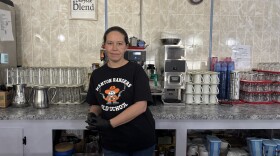Grow & Tell is a biweekly segment you’ll hear on IPR from now through the fall harvest.
Meet up with IPR
Explore native plants with IPR and Grand Traverse Regional Land Conservancy on Monday, April 28. Details here.
Dylan Kulik manages an educational farm at Interlochen Center for the Arts and teaches people how to grow their own food. He'll take you step-by-step through gardening in your backyard or on your windowsill, with tips and plants suited for northern Michigan.
Today: Potting up your seedlings
If you've been following along with the Grow & Tell, you probably have some seeds you started a couple of weeks ago that are now charming little seedlings.
These seedlings, especially the tomato seedlings, will start to grow very quickly and it's vital we upgrade their containers so they can happily grow into adolescent plants and, eventually, fully mature.
The timing for potting up isn't exact, but it usually comes three to five weeks after the seeds germinate and seedlings emerge from the soil.
Our tomato plants are exactly in this range: four weeks since emergence. The bee balm seedlings took a bit longer to grow large enough for handling, and are now five weeks old.
What you'll need
- More potting mix
I am using the same seed-starting soil that I sowed the seeds into. Continue using seed-starting mix or potting mix for this part of the process.
The plants are not yet ready for garden soil, compost or other growing media, but they soon will be.
- Larger containers
This is critical. Choose containers that are at least four times larger than the initial container you started your seeds in.
For the tomatoes I will be using pots that are 3 inches tall, 3 inches wide and 3 inches deep. These can usually hold around 3 to 4 cups of moistened potting mix. I'm using a 72-cell tray for the bee balm seedlings.
- A butter knife, spoon, chopstick or similar
If your plants are large enough to scoop out of their current pots, consider using a spoon or butter knife.
If your plants are still quite tiny, use a chopstick or other clean, stick-like item to gently excavate them and help lift them out of their current homes. Chopsticks are also great for guiding roots downward into the new, larger containers.
For my tomato seedlings, I'm using a spoon since they're fairly large and strong. For my bee balm seedlings, I'm using a chopstick since they are still tiny and they're more crowded. I’ll have to gently tease them apart and pot them up into their own individual larger containers.
Step-by-step instructions
Pot prep
Fill each of your new containers with moistened potting mix and set them aside. Count how many plants you need to pot up from your original seed-starting container and prepare a number of larger containers with moistened potting mix equal to the number of plants.
If there are many small plants clustered together in a single container, decide if you want to save more than one plant from the cluster and prepare larger containers accordingly.
In each larger container, prepare a small hole in the center of the soil for your seedling to be tucked into.
Transfer
One at a time, carefully take the seedlings out of their current containers and immediately tuck them into the larger containers. Roots can dry out quickly and it is best to move plants into new soil as soon as possible.
Once your plant is tucked in, give one final press close to the stem to gently set your plant in place. It's important to make sure the seedlings' stems are as upright as possible; those leaning to the side or falling down won’t grow as happily.
Repeat
Repeat this process until all of your seedlings have nice new accommodations with much more room to grow!
Remember to thoroughly water your plants once they are fully potted up and keep the soil moist, but not dripping, over the next few weeks.
Soon you'll notice new growth on your seedlings and can rest assured that their roots have plenty of room to explore and take hold.











